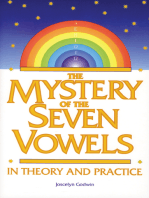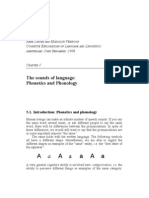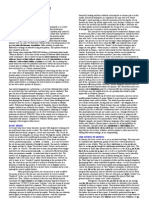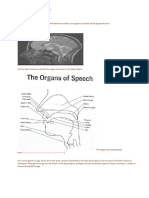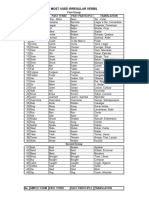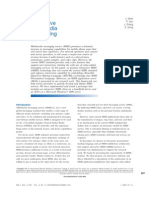Onomotopoeia: L Sounds Are Often Associated With Running Water. in That Sense, Even The Word
Onomotopoeia: L Sounds Are Often Associated With Running Water. in That Sense, Even The Word
Uploaded by
Joanna Erika S. OsiasCopyright:
Available Formats
Onomotopoeia: L Sounds Are Often Associated With Running Water. in That Sense, Even The Word
Onomotopoeia: L Sounds Are Often Associated With Running Water. in That Sense, Even The Word
Uploaded by
Joanna Erika S. OsiasOriginal Title
Copyright
Available Formats
Share this document
Did you find this document useful?
Is this content inappropriate?
Copyright:
Available Formats
Onomotopoeia: L Sounds Are Often Associated With Running Water. in That Sense, Even The Word
Onomotopoeia: L Sounds Are Often Associated With Running Water. in That Sense, Even The Word
Uploaded by
Joanna Erika S. OsiasCopyright:
Available Formats
ONOMOTOPOEIA
Onomatopoeia is the use of the consonant and vowel sounds of a pronounced or "heard" word to imitate, and thereby emphasize or bring to a listener's or reader's imagination, the sounds that might actually be heard in what is being described. In that way, it is a literary device used to make writing or speech more vibrant and effective. It depends on a listener's or reader's ability to hear the sounds of the words. Many words are onomatopoeic in and of themselves, such as "snap" and "scratch." However, the sounds used in speech don't need to be so obvious in order to still constitute onomatopoeia. Some considerations about onomatopoeia have to do with what our natural sounds of speech remind us of. Phoneticians have classified consonant and vowel sounds, and some basic facts seem to be true. The explosive consonant sounds (such as the sound of b, d, k, p and t) seem to bring to mind more violent actions or percussive situations. Consider the following sentence: "The horse trotted and clopped along on the cobblestones." In that, you can hear the horse's hooves on the hard road, if you use your imagination. The sibilant consonant sounds (such as s, sh and f) have a gentler sound, and are often used in descriptions of water or flowing motions: "The shore was washed with every wave, revealing shells and sand with every pass." In that sentence, you can imagine the sound of ocean waves. The z sound is often used for buzzing sounds, but you don't have to use the word "buzz" to get across the idea: "The bees, a blurry swarming fuzz of wings, are hungry for pollen, and they warn me off with the threat of stings." There are several n, ng and z sounds in that sentence, which help a reader or listener to imagine the buzz of a bee. L sounds are often associated with running water. In that sense, even the word liquid is onomatopoeic.
Some research has also been done on how vowel sounds affect emotion or imagination. Vowel sounds range from low-pitched sounds, such as ahhh, to highpitched, such as eee and ayyy. The lower pitched sounds generally contribute to a perception of somberness, slowness or sadness; while the higher pitched sounds generally convey a feeling of excitement or urgency: "He tried to steer clear, but the screech of tires and metal pierced his hearing." "The long and awful funeral march wound through the dark autumn toward the graveyard." Those example sentences combine several qualities of tone, cadence and sound. But they illustrate how vowel sounds also can contribute to onomatopoeic effect. To recognize onomatopoeia, you must hear the words, either read aloud or in your imagination. To use onomatopoeia, you must think of words that contain sounds that you think the reader or listener should hear, that would be appropriate for the action or situation being described.
KULIAT SONG
1. Words Related to Water These words often begin with sp- or dr-. Words that indicate a small amount of liquid often end in -le (sprinkle/drizzle). bloop splash spray sprinkle squirt drip 2. Words Related to the Voice Sounds that come from the back of the throat tend to start with a gr- sound whereas sounds that come out of the mouth through the lips, tongue and teeth begin with mu-. giggle growl grunt gurgle mumble murmur bawl belch chatter blurt 3. Words Related to Collisions Collisions can occur between any two or more objects. Sounds that begin with cl- usually indicate collisions between metal or glass objects, and words that end in -ng are sounds that resonate. Words that begin with th- usually describe dull sounds like soft but heavy things hitting wood or earth. bam bang clang clank clap clatter click
clink ding jingle screech slap thud thump 4. Words Related to Air Because air doesnt really make a sound unless it blows through something, these words describe the sounds of air blowing through things or of things rushing through the air. 'Whisper' is on this list and not the voice list because we do not use our voices to whisper. We only use the air from our lungs and the position of our teeth, lips and tongues to form audible words. flutter fisst fwoosh gasp swish swoosh whiff whoosh whizz whip whisper 5. Animal Sounds If youve spent significant amounts of time with people from other countries, you know that animals speak different languages too. Depending on where a chicken is from, for example, she might cluck-cluck, bok-bok, tok-tok, kot-kot or cotcotcodet. In the United States, however, animals speak English: arf baa bark bray
buzz cheep chirp chortle cluck cock-a-doodle-doo cuckoo hiss meow moo neigh oink purr quack ribbit tweet warble drizzle
You might also like
- The Mystery of the Seven Vowels: In Theory and PracticeFrom EverandThe Mystery of the Seven Vowels: In Theory and PracticeRating: 4 out of 5 stars4/5 (9)
- Voice Accent NeutralizationDocument71 pagesVoice Accent Neutralization테레 Hernandez50% (2)
- TOPIC 3 Development of Education in Malaysia Pre - IndependenceDocument49 pagesTOPIC 3 Development of Education in Malaysia Pre - IndependenceBI20921 Kiroshini A/P MadavanNo ratings yet
- 11 OnomatopoeiaDocument11 pages11 OnomatopoeiaEsatEccoGicićNo ratings yet
- Onomatopoeia DefinitionDocument3 pagesOnomatopoeia DefinitionAnggelia Natalsya EmorNo ratings yet
- Phonology VowelDocument6 pagesPhonology VowelAnam MusholliNo ratings yet
- 11 OnomatopoeiaDocument1 page11 Onomatopoeiasammer30No ratings yet
- Words That Go Ping Chapter SamplerDocument19 pagesWords That Go Ping Chapter SamplerAllen & UnwinNo ratings yet
- What Is An OnomatopoeiaDocument6 pagesWhat Is An OnomatopoeiawysacadNo ratings yet
- Linguistics Reading 2Document11 pagesLinguistics Reading 2AlexahaleNo ratings yet
- OnomatopoeiaDocument4 pagesOnomatopoeiaJacob BoldwinNo ratings yet
- What Is Phonetics (Material 4)Document9 pagesWhat Is Phonetics (Material 4)Jorge Luciano OntiveroNo ratings yet
- J ctv9zcjkw 5Document38 pagesJ ctv9zcjkw 5PRECIOUSNo ratings yet
- The Classification and Description of Speech Sounds in English LanguageDocument6 pagesThe Classification and Description of Speech Sounds in English LanguageNaeemNo ratings yet
- 1.1 & 1.2 Phonetics and Ipa (Introduction)Document16 pages1.1 & 1.2 Phonetics and Ipa (Introduction)Kristel Joy Adorador CarmonaNo ratings yet
- Voice Acoustics1Document28 pagesVoice Acoustics1psykosomatikNo ratings yet
- Week 1: Mythology and Folklore English Class Professor: John Michael CulturaDocument7 pagesWeek 1: Mythology and Folklore English Class Professor: John Michael CulturaMichaels CulturaNo ratings yet
- Figures of Speech-LectureDocument6 pagesFigures of Speech-LectureRezitte Jonathan Annika MablesNo ratings yet
- (Ems) OnomatopoeiaDocument12 pages(Ems) OnomatopoeiaInessy Tika RahayuNo ratings yet
- Phonetic Expressive Means...Document6 pagesPhonetic Expressive Means...badalyan.nairuhiNo ratings yet
- InventionDocument3 pagesInventionClariz Angelika EscocioNo ratings yet
- Dr. Riceli C. Mendoza University of Southern Mindanao PhilippinesDocument17 pagesDr. Riceli C. Mendoza University of Southern Mindanao PhilippinesJose Luis Gatillon SotoNo ratings yet
- Definition of VowelsDocument5 pagesDefinition of VowelsHillary NduNo ratings yet
- Water Onomatopoeia ExamplesDocument8 pagesWater Onomatopoeia ExamplesCristina Maria NistorNo ratings yet
- Yanuar Luhur KurniawanDocument7 pagesYanuar Luhur KurniawanYanuar Luhur KurniawanNo ratings yet
- CONSONANTSDocument6 pagesCONSONANTSnadia nur ainiNo ratings yet
- Jumong EnglishDocument46 pagesJumong EnglishkayeNo ratings yet
- Onomatopoeia in English and IndonesianDocument7 pagesOnomatopoeia in English and IndonesianArtaria NurainiNo ratings yet
- Chapter 6 - Fricatives and AffricatesDocument7 pagesChapter 6 - Fricatives and AffricatesXuân HoàngNo ratings yet
- PhoneticsDocument29 pagesPhoneticsYolowii XanaNo ratings yet
- Sounds and LettersDocument5 pagesSounds and Lettersgardia1261No ratings yet
- Consonants and Vowels: John GoldsmithDocument32 pagesConsonants and Vowels: John GoldsmithCeek Yatt AhmadNo ratings yet
- English ConsonantsDocument28 pagesEnglish ConsonantsIzzati AzmanNo ratings yet
- The American Spelling BookDocument113 pagesThe American Spelling BookblueiconusNo ratings yet
- Hay Wingo PhonicsDocument118 pagesHay Wingo PhonicsLina Pranata100% (1)
- Avh-Chapter 2Document8 pagesAvh-Chapter 2Minh TríNo ratings yet
- Intro Ling Unit 3Document14 pagesIntro Ling Unit 3Zain ChNo ratings yet
- American English Pronunciation TranscriptsDocument219 pagesAmerican English Pronunciation TranscriptsRosangela PiresNo ratings yet
- Pronunciation: Nama: Farid Alfarizi NIM: 1882050020 Prodi: Pendidikan Bahasa InggrisDocument9 pagesPronunciation: Nama: Farid Alfarizi NIM: 1882050020 Prodi: Pendidikan Bahasa InggrisFarid AlfariziNo ratings yet
- Consonants and Allophonic VariationDocument33 pagesConsonants and Allophonic VariationAgustina AcostaNo ratings yet
- The Description of SpeechDocument6 pagesThe Description of Speechdilarasc2121No ratings yet
- Puan MaharaniDocument5 pagesPuan MaharaniKuntinyo unessNo ratings yet
- American English Sounds3 (1)Document20 pagesAmerican English Sounds3 (1)Bahareh KarbalaeiNo ratings yet
- Meaning of SyllalbleDocument13 pagesMeaning of SyllalbleEsha MalikNo ratings yet
- BookDocument23 pagesBookSkyWalker1707No ratings yet
- English Vowel SoundsDocument4 pagesEnglish Vowel SoundsSiddhartha Mishra100% (1)
- Vowel and ConsonantDocument37 pagesVowel and Consonantvillacencioben8No ratings yet
- Phonetic Stylistic DevicesDocument5 pagesPhonetic Stylistic DevicesMasha YashchukNo ratings yet
- Chp.2 Introducing PhonologyDocument8 pagesChp.2 Introducing PhonologySaif Ur RahmanNo ratings yet
- Phonetic Sounds 3Document30 pagesPhonetic Sounds 3saidivyakeerthikalaiNo ratings yet
- Formal Properties of Language: Form of The MessageDocument55 pagesFormal Properties of Language: Form of The MessagePragyan AgrawalNo ratings yet
- Zusammenfassung YuleDocument18 pagesZusammenfassung Yulethatguythough100% (1)
- Homonyms: Homonyms, Homophones and HeteronymsDocument9 pagesHomonyms: Homonyms, Homophones and HeteronymsKisha Hadji NoorNo ratings yet
- Quenya LessonsDocument75 pagesQuenya Lessonssparta3027955No ratings yet
- Marlon Jay Bernasor Re Echo TopicDocument14 pagesMarlon Jay Bernasor Re Echo TopicDiayanara Rose Santiago CachoNo ratings yet
- Phonetics ManualDocument8 pagesPhonetics ManualVenky VenkateshNo ratings yet
- Mid PhonologyDocument4 pagesMid PhonologysyarafinaNo ratings yet
- Phonemes Distinctive Features Syllables Sapa6Document23 pagesPhonemes Distinctive Features Syllables Sapa6marianabotnaru26No ratings yet
- Place of Articulation: BilabialsDocument2 pagesPlace of Articulation: BilabialsPoppy FebrianaNo ratings yet
- The Human Speech ApparatusDocument10 pagesThe Human Speech ApparatusRunato Basanes100% (1)
- Phonetics and Phonology Grup 18Document18 pagesPhonetics and Phonology Grup 18Cholif Lespa TrionoNo ratings yet
- AlgorithmsDocument2 pagesAlgorithmsWhale HeltonNo ratings yet
- UDTKDocument42 pagesUDTKkatieduong2002No ratings yet
- A Tell-Tale Heart VocabularyDocument2 pagesA Tell-Tale Heart VocabularycorinnelimcheongNo ratings yet
- 100 Irregular VerbsDocument2 pages100 Irregular VerbsSofía Fernández PerdomoNo ratings yet
- CH 5 - Number SystemDocument17 pagesCH 5 - Number SystemAryanNo ratings yet
- My ShopDocument40 pagesMy ShopItaliya BhaktiNo ratings yet
- Books & Ebooks - APA Citation Guide (7th Edition) - LibGuides at Columbia College (BC)Document6 pagesBooks & Ebooks - APA Citation Guide (7th Edition) - LibGuides at Columbia College (BC)Matthew TanNo ratings yet
- Guideline #3-Take The Active ChoiceDocument2 pagesGuideline #3-Take The Active ChoiceMonica HopkinsNo ratings yet
- Lesson Plan - Aztec Social HierarchyDocument3 pagesLesson Plan - Aztec Social Hierarchyapi-283598007No ratings yet
- الخطة الفصلية لمادة اللغة الانجليزية الصف الرابع المنهاج القطري الفصل الدراسي الأول 2018-2019Document7 pagesالخطة الفصلية لمادة اللغة الانجليزية الصف الرابع المنهاج القطري الفصل الدراسي الأول 2018-2019Mohamed Da AnaNo ratings yet
- Past Events and Timeline WorkshopDocument7 pagesPast Events and Timeline WorkshopGabriel GutierrezNo ratings yet
- Fables and idiom stories - 井底之蛙Document3 pagesFables and idiom stories - 井底之蛙cc LinNo ratings yet
- Conectores C1Document3 pagesConectores C1Miguel MarsNo ratings yet
- Document 786553.1Document18 pagesDocument 786553.1varachartered283No ratings yet
- Iaa Yearbook02 1998Document92 pagesIaa Yearbook02 1998Bosko DrobnjakNo ratings yet
- High KnowledgeDocument6 pagesHigh KnowledgeMike RigginsNo ratings yet
- CVDocument3 pagesCVManiya Dianne ReyesNo ratings yet
- iMMS: Interactive Multimedia Messaging Service: J. Shen P. Sun J. Zhang S. SongDocument7 pagesiMMS: Interactive Multimedia Messaging Service: J. Shen P. Sun J. Zhang S. Songapi-3723176No ratings yet
- Cal - Zill - Sol - InvCálculo Trascendentes Tempranas 4ta Edicion Denis G. Zill, Warren Wright Sol PDFDocument5 pagesCal - Zill - Sol - InvCálculo Trascendentes Tempranas 4ta Edicion Denis G. Zill, Warren Wright Sol PDFDiego AlejandroNo ratings yet
- Quiz-Simple Present Past FutureDocument2 pagesQuiz-Simple Present Past FutureLecia zafiraNo ratings yet
- XVKV Iwm WBWMQVJ G WJ K JR: Class: Three Subject: English 1St PaperDocument82 pagesXVKV Iwm WBWMQVJ G WJ K JR: Class: Three Subject: English 1St PaperPNo ratings yet
- RX8200 Receiver UpdateDocument7 pagesRX8200 Receiver UpdateRobertNo ratings yet
- Plan Sheet For Character Analysis Paragraph + ExamplesDocument2 pagesPlan Sheet For Character Analysis Paragraph + ExamplesMrHelland100% (9)
- Lecture 1 - Introductions & Oneness Theology Proper (Students)Document22 pagesLecture 1 - Introductions & Oneness Theology Proper (Students)javier andres gonzalez cortesNo ratings yet
- Supplementary Lesson - Basic MariologyDocument4 pagesSupplementary Lesson - Basic MariologyKiel GatchalianNo ratings yet
- Ma'asyiral Muslimin RahimakumullahDocument3 pagesMa'asyiral Muslimin RahimakumullahHarun IsmailNo ratings yet
- Abū Yazīd of Bistām A Turning-Point in Islamic MysticismDocument16 pagesAbū Yazīd of Bistām A Turning-Point in Islamic Mysticismcha072No ratings yet
- AdverbsofFrequency 1Document22 pagesAdverbsofFrequency 1Samiiee BanderasNo ratings yet
- PraiseDocument2 pagesPraiseSamNo ratings yet
